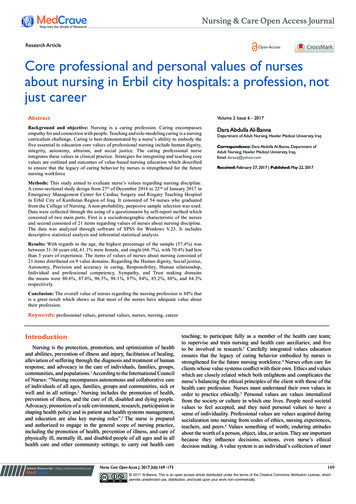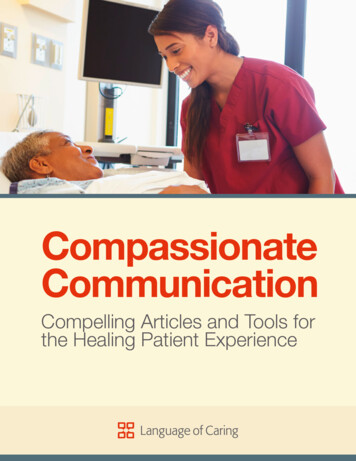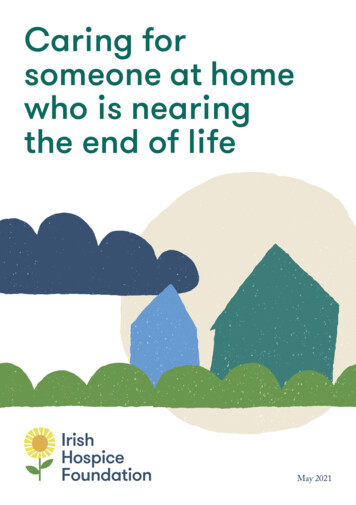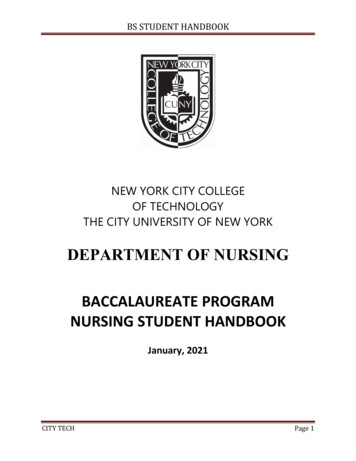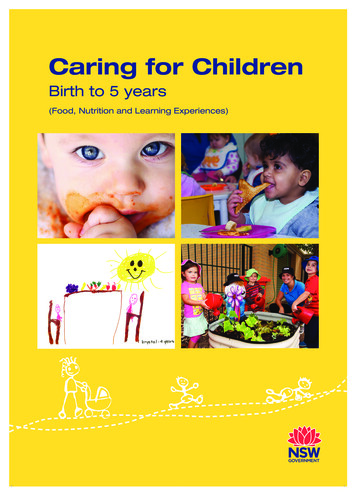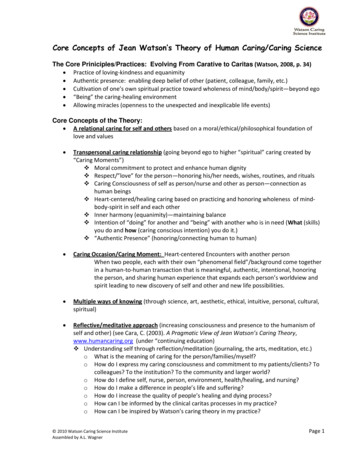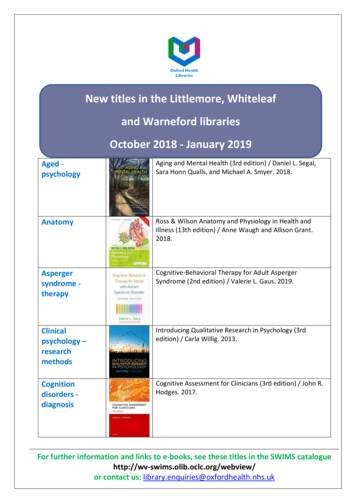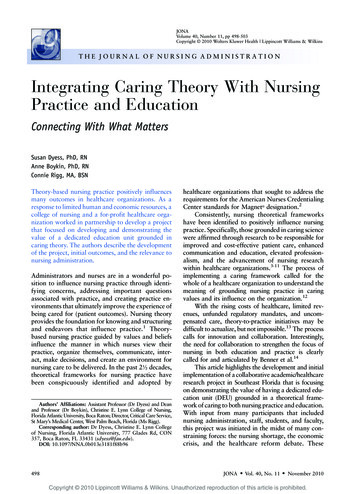
Transcription
JONAVolume 40, Number 11, pp 498-503Copyright B 2010 Wolters Kluwer Health Lippincott Williams & WilkinsTHE JOURNAL OF NURSING ADMINISTRATIONIntegrating Caring Theory With NursingPractice and EducationConnecting With What MattersSusan Dyess, PhD, RNAnne Boykin, PhD, RNConnie Rigg, MA, BSNTheory-based nursing practice positively influencesmany outcomes in healthcare organizations. As aresponse to limited human and economic resources, acollege of nursing and a for-profit healthcare organization worked in partnership to develop a projectthat focused on developing and demonstrating thevalue of a dedicated education unit grounded incaring theory. The authors describe the developmentof the project, initial outcomes, and the relevance tonursing administration.Administrators and nurses are in a wonderful position to influence nursing practice through identifying concerns, addressing important questionsassociated with practice, and creating practice environments that ultimately improve the experience ofbeing cared for (patient outcomes). Nursing theoryprovides the foundation for knowing and structuringand endeavors that influence practice.1 Theorybased nursing practice guided by values and beliefsinfluence the manner in which nurses view theirpractice, organize themselves, communicate, interact, make decisions, and create an environment fornursing care to be delivered. In the past 22 decades,theoretical frameworks for nursing practice havebeen conspicuously identified and adopted byAuthors’ Affiliations: Assistant Professor (Dr Dyess) and Deanand Professor (Dr Boykin), Christine E. Lynn College of Nursing,Florida Atlantic University, Boca Raton; Director, Critical Care Service,St Mary’s Medical Center, West Palm Beach, Florida (Ms Rigg).Corresponding author: Dr Dyess, Christine E. Lynn Collegeof Nursing, Florida Atlantic University, 777 Glades Rd, CON357, Boca Raton, FL 33431 (sdyess@fau.edu).DOI: 10.1097/NNA.0b013e3181f88b96498healthcare organizations that sought to address therequirements for the American Nurses CredentialingCenter standards for Magnet designation.2Consistently, nursing theoretical frameworkshave been identified to positively influence nursingpractice. Specifically, those grounded in caring sciencewere affirmed through research to be responsible forimproved and cost-effective patient care, enhancedcommunication and education, elevated professionalism, and the advancement of nursing researchwithin healthcare organizations.3-11 The process ofimplementing a caring framework called for thewhole of a healthcare organization to understand themeaning of grounding nursing practice in caringvalues and its influence on the organization.12With the rising costs of healthcare, limited revenues, unfunded regulatory mandates, and uncompensated care, theory-to-practice initiatives may bedifficult to actualize, but not impossible.13 The processcalls for innovation and collaboration. Interestingly,the need for collaboration to strengthen the focus ofnursing in both education and practice is clearlycalled for and articulated by Benner et al.14This article highlights the development and initialimplementation of a collaborative academic/healthcareresearch project in Southeast Florida that is focusingon demonstrating the value of having a dedicated education unit (DEU) grounded in a theoretical framework of caring to both nursing practice and education.With input from many participants that includednursing administration, staff, students, and faculty,this project was initiated in the midst of many constraining forces: the nursing shortage, the economiccrisis, and the healthcare reform debate. TheseAJONA Vol. 40, No. 11 November 2010Copyright @ 2010 Lippincott Williams & Wilkins. Unauthorized reproduction of this article is prohibited.
constraints posed challenges that were recognizedlocally as well as nationally. Nonetheless, the projectpersevered and continues.ChallengesNurses as ResourcesThe appropriate availability of competent and compassionate nurses as a human resource is itself anissue. The recent trends of nursing turnover, struggles,and costs associated with on-boarding of new nursesand an education-practice gap are formidable challenges receiving widespread attention from nursingexecutives.13,15-21 Another challenge was the shortage of nurses. In Florida, the nursing shortage waspredicted to reach 18,000 full-time-equivalent RNsin 2010. Nationally, it was reported that 41% ofnurses currently employed in hospitals were not happily employed, and 22% of them planned to leavetheir positions within the year.22 These data coupledwith the rapidly increasing average age of practicingnurses and looming retirements increased the desirefor the collaboration to positively influence practiceand education.Economic ResourcesExacerbating the human resource challenge were theeconomic instability and associated challenges facedby healthcare organizations. In a speech, Romer23noted that President Obama Bis urging healthcarereform to slow the growth rate of spending, tamethe budget deficit, and provide all Americans withthe secure health insurance coverage.[ Romer statedthat despite the American Recovery and Reinvestment Act, during the first quarter of 2009 Americalost nearly 700,000 jobs per month. Economicroadblocks and conditions such as these were notseen since the Great Depression of 1929. The financial restraints directly impacted the rate of reimbursement for healthcare rendered to those who hadcoverage as well those who were uninsured or underinsured. Additionally, the high jobless rates hovering at 10% together with the devastated regional realestate markets adversely impacted the ability torecruit experienced nurses from other locales toFlorida.In response to the human and economic resourceissues, the chief nursing officer of the healthcareorganization was eager to engage in this project. Along-standing relationship between the healthcareand academic organizations existed that fostered thenatural development of a collaborative project designed to address both the human and economic resource issues and the call for integrating nursingtheory more intentionally with practice. Human andfinancial resources were pooled from the healthcareorganization and academia for the project.The ProjectThe design of the DEU was loosely linked to the concept described by others in recent published literature.24 Conceptually, the Moscato et al24 model wasdeveloped to address the demand for quality nursingpractice settings that would accommodate nursingstudents and support nursing staff who were performing in highly stressful situations. Their modelserved as a guide for the evolvement of our uniquemodel, which was intentionally focused on connecting baccalaureate, master, and doctoral nursingstudents, expert nurses, nursing leadership, and faculty to cocreate nursing practice grounded in caringtheory. Nursing students experienced firsthand theliving of theory-guided nursing practice, gained nursing practice experience in a for-profit community hospital, conducted research, and studied nursing withseasoned expert practitioners. The seasoned nurseshad the opportunity to be revitalized by engaging indialogue on caring theory, specifically Nursing asCaring (NAC),25 and by intentionally reshaping theirpractice and that of the unit. This collaborationcreated excitement and growing commitment.Prior to undertaking this research project, thehealthcare organization did not have a specific theoryof nursing to guide practice. The selection of theNAC25 was appropriate because it was congruentwith the historical faith-based values and ideals ofthe organization. Most of the beliefs and values ofthe theory were relevant across disciplines and departments. The NAC grand theory provided key conceptual ideas for our collaborative team to elucidateand allowed for flexibility in actualizing the framework within nursing practice.Initial dialogue made explicit a call for a way ofrelating that was respectful and honored all persons.To align with the selected theoretical framework, weexplored what Boykin and Schoenhofer25 refer to asthe Dance of Caring Persons25(p37) (Figure 1). Theimage of a dance conveyed a way of being with othersin which each person is known, respected, andvalued. Everyone participating in the DEU was considered to be part of the dance and in the dance wasunderstood to be a caring person who was contributing his/her unique gifts and talents to the project.Also, within the dance, each person offered his/herdistinctive contributions as appropriate to his/her roleas called for by the one nursed. The idea of a circlefurther implied that there was no hierarchy of positions but rather the recognition and celebration of thecontributions of all involved. The many dancers in theJONA Vol. 40, No. 11 November 2010Copyright @ 2010 Lippincott Williams & Wilkins. Unauthorized reproduction of this article is prohibited.499
Figure 1. Dance of Caring Persons. Boykin andSchoenhofer.25(p37)DEU are reflected in Figure 2. This model was used asa dynamic guide for the unfolding research project.The dance came to represent the deliberate connectingof all persons involved in the care of those nursed.All staff members were invited on a weekly basisto share in dialogues of how they live caring uniquelyin practice. The initial group was small and composedof committed nurse administrators, nurses, and staff.The small group met weekly to align expectations forthe project and establish an understanding of theoretical concepts and overarching guidelines. Once theproject was conceptually formed, appropriate institutional review board approval was acquired to ensurethe ethical protection of all participants involved withthe DEU. As the project took form, the initial smallgroup grew as nurses, staff members, and studentswere again invited to join our Bcaring dialogues.[Understanding the theoretical assumptions andimportant concepts of NAC25 required time. Dialogueon this theory began about 4 months prior to the official initiation of the DEU. During this time, therewere weekly gatherings with staff focused on connecting, valuing, reflecting, and dialogue on caring values.26 Within the caring dialogues, we began to focusour thoughts on reflective knowing and appreciationof the caring knowledge embedded in stories of practice or nursing situations. The caring dialogue modelis reflected in Figure 3. Caring intention was often related through dialogue as nursing situations wereshared in moment-to-moment expressions of authenticity with all of the DEU collaborators. Caring wassupported and known within one-to one conversationsand group gatherings. Transformation had begun.Ultimately, the leadership of the DEU researchproject was under the direction of the chief nursingofficer of the healthcare organization and the dean of500the academic institution. In addition to their seniorleadership, the practice setting clinical director and aproject coordinator were involved. The project coordinator was a doctoral prepared nurse who acted as aliaison among members of the dance (Figure 2).Her responsibilities included day-to-day coordination, creating opportunities to further the understanding of NAC theory among staff and students,and serving as a role model. Other dancers in themodel included a clinical instructor from the collegewho was responsible for coordinating and evaluatingthe student experience with the nursing practicementors (staff nurses). The nursing practice mentorswere expert staff nurses who committed themselves tothe project and who were vested in the transformationof the nursing practice setting. The mentors providedmodeling of clinical and technological expertise forthe students. Additionally, the practice mentors wereable to codiscover and live NAC, side-by-side with allmembers of the dance.Nursing as Caring TheoryMuch of what is known about caring in generic termscomes from the thoughtful work of Mayeroff.27 Inhis scholarly work, he identifies Bingredients ofcaring[Vknowing, alternating rhythm, hope, courage, trust, humility, patience, and honesty. Theseingredients are useful in helping one to understandthe ambiguous concept of caring as one is calledto reflect on how each of these ingredients is liveduniquely every day. This understanding of living caringand knowing self as caring is the basis for knowingother as caring. From the very early stages of thisproject and continuing throughout, there has been afocus on coming to know self and other as caringand to appreciate unique expressions of caring.Figure 2. The many dancers in the dedicated educationunit.JONA Vol. 40, No. 11 November 2010Copyright @ 2010 Lippincott Williams & Wilkins. Unauthorized reproduction of this article is prohibited.
Figure 3. The Nursing as Caring practice model.The theoretical lens of NAC asserts that thefocus of nursing is Bnurturing persons living andgrowing in caring.[25(p12) The theoretical assumptions of NAC are listed in Figure 4. Weeklysemistructured dialogues among project membersfocused on understanding these assumptions andkey conceptual ideas inherent to NAC. One centralconcept is that of the nursing situation. Boykin andSchoenhofer25 believe that the knowing of nursingis embedded within the nursing situation, which isdefined Bas a shared lived experience in which thecaring between nurse and nursed enhances personhood.[25(p13) Reflection upon nursing situations ofpractice provided exquisite opportunities for uncovering the knowledge and essence of caring innursing. The nurses’ intentional presence in thesesituations allowed for calls for nursing to be heardand responded to in a person-focused way. As professionals and nonprofessionals shared their important stories, unique gifts were illuminated andillustrated how each person lives caring uniquelywithin the organization. Knowing and valuing othersassociated with nursing situations created, maintained, and supported a caring environment.Nursing situations written by undergraduate students and nursing staff were shared in weekly gather-ings. The situations shared focused on the person(s)nurses but often involved many that included administrators, nurses, staff members, nursing practicementors, and nursing faculty. One example of a sharednursing situation was complex and centered on aharried code-blue response for a woman living withnumerous chronic conditions. The code-blue eventoccurred during the time of shift change, and it waschaotic and replete with emotions. The caring dialogue within the DEU was able to facilitate understanding perspective of students, nurses, and staff.Reflections on this nursing situation provided opportunity to know how caring was lived compassionatelyand uniquely. The transformation of perceptions forthe code-blue event that occurred reveals that in themidst of chaos and unfortunate but inevitable patientoutcomes, caring can be recognized and celebrated.The caring dialogue also demonstrated that theknowledge gleaned from the study of a nursingsituation and a focus on shared values strengthen theunderstanding of living and practicing caring.Another essential NAC25 concept that had greatmeaning for the project participants was Bdirect invitation.[ Although the intention of this concept isrelated to the nurse coming to know the person nursedas caring by inviting him/her to help the nurse toknow what matters most to him/her in the moment,the staff expanded the use of this concept to identifywhat matters most to them as dancers in the circle. Itwas recognized that an important concern for nurseswas a desire to create a work environment reflectiveof caring values and to consider a journey towardBeacon recognition.28 Their hope for future was tobe recognized as a Beacon unit by the AmericanAssociation of Critical-Care Nurses. On a number oflevels, all members of the dance appeared to be committed to creating a practice environment grounded inNAC and to advancing the goals of the DEU.OutcomesElements of transformation are already notable in thehealthcare organization. These initial outcomes arethe by-products of initiating a collaborative projectFigure 4. Major assumptions of Nursing as Caring.JONA Vol. 40, No. 11 November 2010Copyright @ 2010 Lippincott Williams & Wilkins. Unauthorized reproduction of this article is prohibited.501
that links a healthcare organization and an academicinstitution. These initial outcomes are the transformative changes in the nursing practice environmentthat now exist when they did not exist prior to ourDEU. They include (a) a growing appreciation forknowing self and other as caring; (b) a cadre ofclinically seasoned and dedicated staff nurses whosupport the advancement of theory-based professional nursing care rendered to patients; (c) committed members of an administrative team and expertnurses eager to mentor staff and promote theorybased quality care as they embark upon a journeytoward Magnet recognition; (d) dedicated educatorson the DEU who model the living of theory-basedpractice with students in all programs of study; (e)inspired student nurses seeking employment withinthe DEU; (f) a theoretical model using NAC foradvancing efforts toward the journey of Beacon recognition; and (g) an opportunity to support thetransition and on-boarding of new nurses into thecritical care environment is enhanced.Lessons learned from this project have significantimplications for nurse administrators. The role ofnurse administrator is directly linked to an understanding of nursing as a practice discipline. When thepractice of nursing administration is grounded inNAC, it is understood that all activities are ultimatelydirected to care for persons nursed. The role of thenursing administrator in the Dance of Caring Personsis to create, maintain, and support Ban environment inwhich calls for nursing are heard and nurturingresponses are given.[25(p33) The nurse administratoris committed to hearing the stories of nursing practice to secure resources essential to the goals of nursing, grounding the organization in caring values, andcommunicating nursing’s unique contribution.the healthcare environment; other nursing professionals in other communities are also involved withthis important work.8 The presented DEU modelconnected caring theory with the practice and educational arms of nursing. This model merged thestrengths of experts in practice settings with theexperts in academic settings, resulting in synergiesthat allowed cocreation, transformation, and anexpanded understanding of theory linked to nursingpractice.For our particular DEU, the effectiveness of theproject will continue to be measured in multiple waysat the 1- and 2-year points of the project. Preprojectmeasurements were taken with 3 tools: the CaringBehaviors Inventory 24,29 the Horizontal ViolenceSurvey,30 and Healthy Work Environment Measure.28 Postproject measurements have not yet beendone. Other preproject and postproject measuresinclude the vacancy and retention rates as well as thehealthcare organization’s own standardized nursingsatisfaction scale. Focus groups and interviews withmembers of the dance are also being conducted tobetter understand the experience of living caring inpractice. As our understanding of nursing education,31nursing practice,4-7 and integration of theory3 issupported, the DEU is unfolding.This project demonstrates the value of implementing caring theory within a healthcare organization for nursing administrators, expert nurses,nursing faculty, students, and new nurses. Our DEUproject has begun, and the efforts are important stepsto advancing the reality of theory integration.Felgen8 states, BCaring has its greatest value whenit lives in the organization, in daily interactions, injob descriptions, and performance appraisals, and ismost precious when it is seemingly invisible.[8(p214)SummaryAcknowledgmentResearch findings that integrate caring within practice inspired our innovative design of the DEU inThe authors thank all members of the DEU dancefor their collective contributions.References1. Sumner J. The foundation of advanced practice nursing. TopAdv Pract Nurs. 2005;4(4):1-3.2. American Nurses Credentialing Center. Magnet RecognitionProgram Application Manual. Silver Spring, MD. AmericanNurses Credentialing Center; 2005.3. Birk L. The Magnetism of theory: resonance to radiance.JONA. 2007;37(3):144-149.4. Boykin A, Bulfin S, Baldwin J, Southern R. Transformingcare in the emergency department. Top Emerg Med. 2004;26(4):331-336.5. Boykin A, Bulfin S, Schoenhofer S, Baldwin J, McCarthy D.502Living caring in practice: the transformative power of thetheory of nursing as caring. Int J Hum Caring. 2005;9(3):15-19.6. Boykin A, Schoenhofer SO. The role of nursing leadership increating caring environments in health care delivery systems.Nurs Adm Q. 2001;25(3):1-7.7. Boykin A, Schoenhofer S, Smith N, St Jean J, Aleman D.Transforming practice using a caring based nursing model.Nurs Adm Q. 2003;27(3):223-230.8. Felgen J. Caring: core value, currency, and commodityI isit time to get tough about Bsoft?[ Nurs Adm Q. 2003;27(3):208-214.JONA Vol. 40, No. 11 November 2010Copyright @ 2010 Lippincott Williams & Wilkins. Unauthorized reproduction of this article is prohibited.
9. Felgen J. A caring and healing environment. Nurs Adm Q.2004;28(4):288-301.10. Pipe TB. Optimizing nursing care by integrating theory drivenevidence based practice. J Nurs Care Qual. 2006;22(3):234-238.11. Watson J. Caring theory as an ethical guide to administrativeand clinical practices. Nurs Adm Q. 2006;30(1):48-55.12. Roch G, Dallaire C O’Neill M, Roy M, Robinette L. Thepolitics of caring: using a political tool to analyze and intervene in the implementation of a caring philosophy in aMontreal hospital. Int J Hum Caring. 2005;9(3):9-14.13. Burritt J, Steckel C. Supporting the learning curve for contemporary practice. JONA. 2009;39(11):479-484.14. Benner P, Sutphen M, Leonard V, Day L. Educating Nurses:A Call for Radical Transformation. San Francisco, CA: JosseyBass; 2010.15. Burns P, Poster EC. Competency development in new Registered Nurse graduates: closing the gap between educationand practice. J Contin Educ Nurs. 2008;39(2):67-73.16. del Bueno DJ. A crisis in critical thinking. Nurs EducPerspect. 2005;26(5):278-282.17. Dyess SM, Sherman R. The first year of practice: new graduate transition and learning needs. J Contin Educ Nurs.2009;40(9):403-410.18. Dyess SM, Sherman RO. Developing a leadership mindset innew graduates. Nurse Lead. 2010;8(1):29-33.19. Jones CB. The costs of nurse turnover: part 1: an economicperspective. JONA. 2004;34(12):562-570.20. Li S, Kenward K. A national survey of nursing educationand practice of newly licensed nurses. JONAS Healthc LawEthics Regul. 2006;8(4):110-115.21. Spector N, Li S. A regulatory model on transitioning nursesfrom education to practice. JONA. 2007;37(1):19-22.22. Florida Center for Nursing. Making the case: improvingretention to address Florida’s nursing shortage. Available athttp://www.flcenterfornursing.org/files/Making the Casefor Retention.pdf. Accessed May 7, 2010.23. Romer CD. So, is it working? An assessment of the AmericanRecovery and Reinvestment Act at the five-month mark.Available at hair-remarks-08062009/. Accessed May 7, 2010.24. Moscato S, Miller J, Logsdon K, Weinberg S, Chorpenning L.Dedicated education unit: an innovative clinical partner education model. Nurs Outlook. 2007;55:31-37.25. Boykin A, Schoenhofer S. Nursing as Caring: A Modelfor Transforming Practice. Sudbury, MA: Jones Bartlett;2001.26. Bankert E, Kozel V. Transforming pedagogy in nursingeducation: a caring learning environment for adult students.Nurs Educ Perspect. 2005;26(4):227-229.27. Mayeroff M. On Caring. New York City, NY: Harper-Collins;1971.28. American Association for Critical-Care Nurses. AACN’s healthywork environments initiative. Available at nu community. AccessedMay 7, 2010.29. Wu Y, Larrabee JH, Putman HP. Caring Behaviors Inventory: a reduction of the 42-item instrument. Nurs Res. 2006;55(1):18-25.30. Longo J. Development of a Horizontal Violence Scale usinga multi-disciplinary approach. South Florida Research Consortium: 3rd annual Research Conference; October 16, 2009;Miami, FL.31. Touhy T, Boykin A. Caring as the central domain in nursingeducation. Int J Hum Caring. 2008;12:(2):8-15.JONA Vol. 40, No. 11 November 2010Copyright @ 2010 Lippincott Williams & Wilkins. Unauthorized reproduction of this article is prohibited.503
Susan Dyess, PhD, RN Anne Boykin, PhD, RN Connie Rigg, MA, BSN Theory-based nursing practice positively influences many outcomes in healthcare organizations. As a . Florida Atlantic University, 777 Glades Rd, CON 357, Boca Raton, FL 33431 (sdyess@fau.edu). DOI: 10.1097/NNA.0b013e3181f88b96
